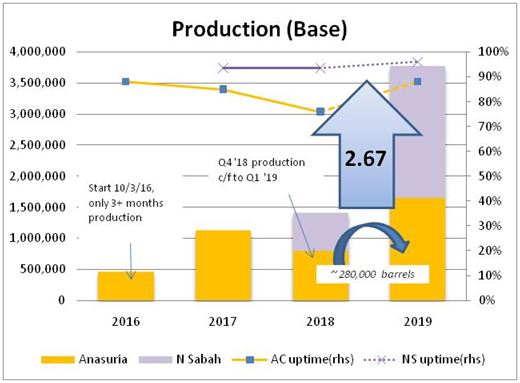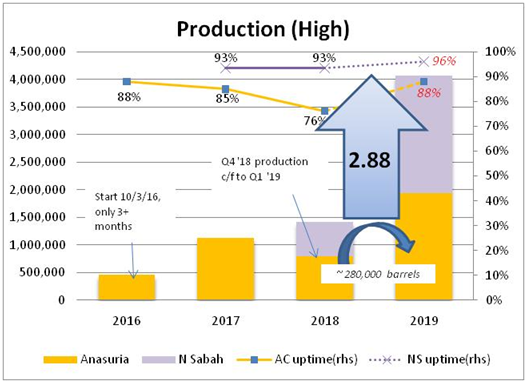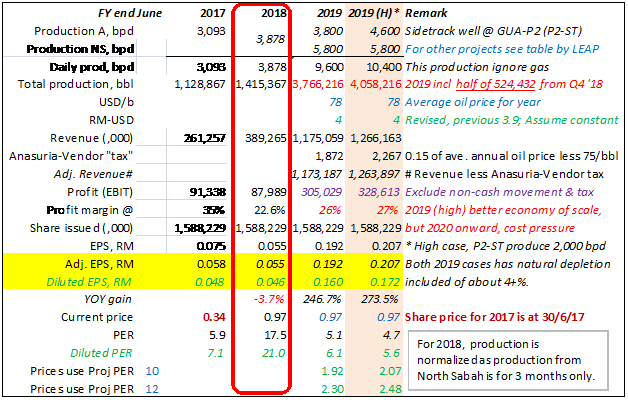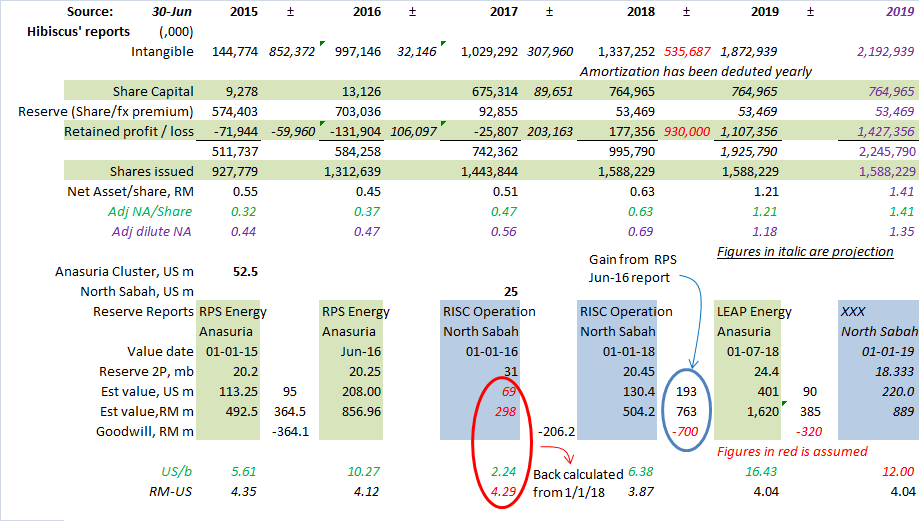Hibiscus - undervalued?
teoct
Publish date: Wed, 12 Sep 2018, 03:46 PM
Hibiscus Petroleum Bhd – undervalued?
Summary
- Anasuria Cluster reserve upgraded to 24.4 mmb and valuation now USD 410 million
- Side-track at GUA-P2 completed on 3/9/18 and test flow-rate net to Hibiscus is 2,375 bpd
- NTA is potentially RM 1.12 to 1.41 for FY 2019
Since my last article on 2/9/18, the above were announced (especially the side-track) that were not accounted in the production estimates. The value of the company was not looked at in detail before.
Further study indicated that the Anasuria Cluster is naturally depleting at around 4% annually. So the GUA-P2 side-track (P2 ST) came at the right time. Two scenarios were taken, one with 1,000 bpd from P2 ST and the other, high case, 2,000 bpd from P2 ST. These production levels assumed an up-time of 88%.
Unfortunately or fortunately there isn’t sufficient data to estimate the depletion rate for North Sabah. The estimated production is revised down to 5,800 bpd from 6,100 bpd for financial year 2019 with an up-time of 96%.
Both production levels are shown in the next two graphs:


The financial figures are as shown below:

Take note the Anasuria-Vendor “tax” included where it become payable should oil price exceed US 75/b.

Source: Hibiscus: Page 4 of circular to shareholder dated 20/1/16
The reason tax was not included was the complexity of it. The focus of the valuation is on how good Management is in extracting oil at the lowest cost possible.
Also with current accounting rules, the frequent (re)valuation of assets (tangible & intangible) are creating a lot of impairment, write-back as well as negative goodwill. Other than negative goodwill, all impairment and write-back has been ignored in the assessment of book value shown below.
 North Sabah was bought for US 25 million, the P2 reserve was given as 31 million barrels. That mean US$ 0.80 per barrel; if the reserve figure taken is correct (the RISC’s report is not available).
North Sabah was bought for US 25 million, the P2 reserve was given as 31 million barrels. That mean US$ 0.80 per barrel; if the reserve figure taken is correct (the RISC’s report is not available).
LEAP valued Anasuria Cluster at US$ 16.43 per barrel while the latest North Sabah (1/1/18) was valued at only US$ 6.38 per barrel. Therefore, there might be another revaluation during the financial year 2019 resulting in a potential Net Tangible Asset (NTA) of RM 1.41 per share.
There could be a perfectly rational reason why North Sabah should be valued lower than North Sea, thus, a lower US$ 12 per barrel and P2 reserve of 18.3 mb (20.45 less 1 year production) was assumed for the potential revaluation.
Today, paying RM 0.97 per share for potentially a RM 1.12 (diluted RM 1.18) NTA is a discount of 20% (diluted 18.5%). (19/9/18 - these discounts were corrected; the diluted NTA per share in the previous table did not take into consideration of the conversion "payment" of Warrant C to "mother" share of RM 1.06 / RM 1.12 in 2020 and 2021 respectively that will then increase the share capital.)
While retained profit appears high, a lot of it is from the negative goodwill and not distributable. Should the oil price fall below US$ 70 per barrel, there might be impairment and this will be backed out of the retained profit. Therefore, the EPS being estimated in the above table ignored this (negative goodwill).
Oil (& gas) exploration / production companies the world over had their reserve valued and parked under intangible asset. Hibiscus is no different.
And as oil (& gas) is produced, amortization is deducted; currently this is around US$ 41 per barrel (sold).
Risk
In some form of order (not strictly) of severity, the risks are;
- Implementing risk (for projects) – over budget, delay in the completion
- Demand risk – trade war could shrink demand leading to softer oil prices
- Reservoirs risk – higher natural depletion rate, higher water oil ratio, higher gas oil ratio, etc.
- Manpower risk – pinching of (production) staffs leading to productivity issues
- Regulator risk – government nationalizing oil fields (very low), change in tax regimes, increase already stringent safety rules, etc
- Have not thought of, Murphy’s Law.
Conclusion
The P2-ST will more than replace the natural depletion of the Anasuria Cluster production. A base case (1,000 bps) and a high case (2,000 bpd) production from P2-ST were considered.
North Sabah was reviewed and revised down to 5,800 bpd from 6,100 bpd.
These revisions would result in a potential 2.67 to 2.88 time increase in production compared with 2018 that will result in much improve cash flow that could cause (identified) projects to be brought forward to further improve production as well as productivity.
An Anasuria Vendor “tax” was included in the financial model to reflect the agreement entered into back in 2015.
With the LEAP Energy’s report on the Anasuria Cluster reserve valued at US$ 16.43 per barrel, the North Sabah reserve could be revalued this financial year 2019 resulting in a potential NTA of RM 1.41/share (RM 1.18 diluted).
IS HIBISCUS NOT UNDERVALUED?!?
Thank you for reading.
Disclosure: I and my family own shares in Hibiscus.
I wrote this article myself, and it expresses my own opinions. I am not receiving compensation for it. I have no business relationship with any company whose stock is mentioned in this article. Buy / sell at your own risk.
Related Stocks
| Chart | Stock Name | Last | Change | Volume |
|---|
More articles on TeoCT
Created by teoct | Jul 23, 2020
Discussions
@eskaylien, the "tax" rate is US$ 0.15 x (US$ Y - US$ 75) per barrel where US$ Y is the annual average oil price in a calendar year. And this is only applicable from 2018 to 2021 only. This rate, US$ 0.15 is considered a windfall payment to the Vendors. The only assumption made was whether this will be applicable to the annual production (of Anasuria) or only those production where the oil price exceeded US$ 75 per barrel.Thank you for reading.
Have a good week ahead.
2018-09-12 21:42
Thanks teoct for very insightful article!
Referring to the 2018 Jun results briefing video (Quarterly Financial Report 30 June 2018 Webcast), it was mentioned that there is planned maintenance to North Sabah fields over the next two financial quarters. Anyone knows...
What is the implication of the maintenance to production?
Does it mean that there will be no oil production from North Sabah over the next two quarters?
What is the frequency for the maintenance? How about Anasuria?
2018-09-15 15:10
@myongcc5, thank you very much for reading and your kind comment. Have a good weekend.
2018-09-15 15:22
There is a lot of interest in a detailed analysis of Sapura.....The IB analysts have not done a good job.
2018-09-15 15:33
@bukithot, from my limited knowledge, the maintenance work will normally not affect the production. Even if it does, it will normally be planned in such a way that there will be minimum disruption to production, i.e. not the whole two quarters there will be no oil production. It does not work like this.
Do not forget, at North Sabah, there are so many wells and platforms and different fields (St Joseph, South Furious, Barton, etc), so maintenance maybe only at St Joseph, say, the other fields are still producing.
And some type of maintenance will, after completion of the maintenance, enhance oil production. But generally, maintenance is to maintain/improve up-time, this is already good. Imagine a bus go into the workshop for quick engine oil change and brake check then back on road carrying paying passengers, up-time. Or major maintenance to lengthen bus to carry more passengers.
Frequency - now, most if not all operators are performing maintenance on need basis rather than time basis. That is, they will monitor the equipment for wear & tear. However it is not so simple as these are offshore (not on land) so it will very much depend on the availability of maintenance resources and some maintenance will be carried out on opportunity basis (of available resources). By and large, frequency maybe a year to a year and a half. For Anasuria, it will be similar subject to the regulation in that jurisdiction.
The implication of maintenance will mean higher cost of production.
Hope this gives a feel to the working of an oil (& gas) production and not confuse you.
Thank you for reading and have a good weekend.
2018-09-15 15:54
@qqq3, thank you for reading. Yes there is a lot of interest in Sapura. From my simple understanding, it own a gas field in Sarawak water (I maybe wrong), and all the others are exploration, that is, no production.
Hibiscus is already producing oil and getting cash for it. Sapura is a dream (exploration), there maybe oil or maybe nothing. Even if they find oil (and in sufficient quantity), to get the oil out will mean another 5 to 7 years down the road. So one is buying a dream. BIG DIFFERENT, DREAM AND CASH.
The remaining part of Sapura business is services to oil (& gas) majors, yes they are winning some contracts but I rather stick to the one that is producing oil, i.e. CASH, NOW (rather than 5 to 7 years later and maybe only).
To some "investors", dream is cool, more sexy even.
Have a good weekend.
2018-09-15 16:14
Do listen to interview at BFM: https://www.bfm.my/bg-kenneth-pereira-hibiscus-petroleum-what-will-fuel-hibiscus-future-growth
2018-12-08 11:52
Dr. Pereira said the new PS2-ST is producing net 1,000 bpd and follow on said Anasuria should be producing 4,200 bpd. Press conference after AGM, he said total production for FY2019 will be 2.7 to 3 mb. Hmm, this is conservative.
But the interesting bit (in the BFM interview) is Marigold and Sunshine, the new North Sea acquisition. This will be developed to produce oil around end 2021 at about 10k to 12k bpd. Should Anasuria and North Sabah maintain current production in FY2022, then total daily production will be about 22kbpd. EPS in 2022 would be 30 sens (oil price USD76 Ex to RM 4). At current price, buying for future (2022 - 3 years time), PER would only be about 3.5.
Potentially, price of Hibiscus in 2022 would be about RM 3.50
Have a good week ahead.
2018-12-08 12:27



















eskaylien
Teoct,
What's the anasuria vendor tax rate when prices exceed USD75?
2018-09-12 16:38